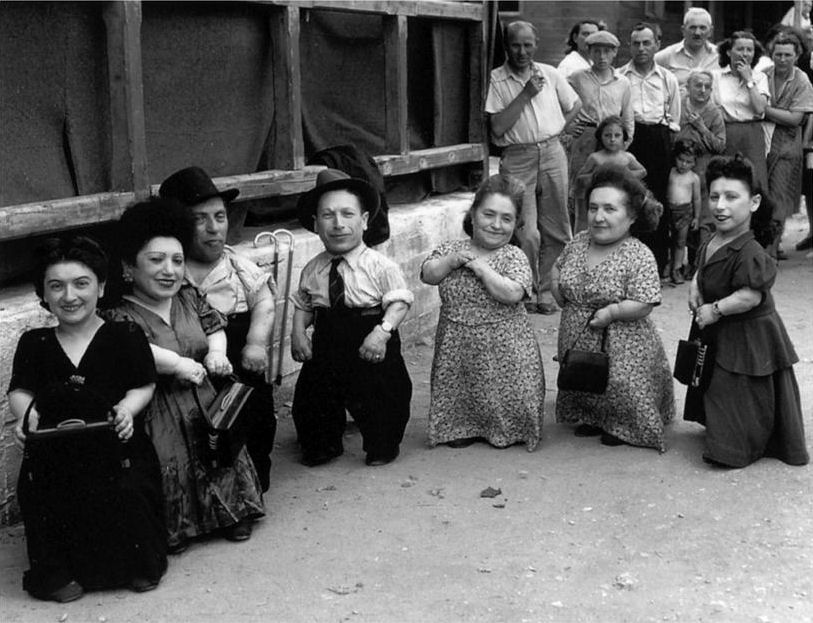

Achondroplasia, an autosomal dominant trait
Achondroplasia is a
class of
skeletal growth syndromes characterized by short stature due
to slow
development of the middle portions of the long bones in the
arms and
legs. The most common form of achondroplasia (left) is due to a
defect of the Fibroblast
Growth Factor Receptor (FGFR),
and is recognized by exaggerated cranial growth and bossing
(depression) at the bridge of the nose. A second form is pseudoachrondroplasia (right), which is due
to a defect
of Cartilage Oligomeric
Matrix Protein
(COMP) in the
joints, and is
characterized by
more typical
development of cranial proportions. Both forms are described as sporadic,
meaning that they occurs in different families due to
independent
mutations. Thus,
most
affected children are born to parents of ordinary stature,
one of whom has a germline mutation. In the children of two
parents
with achondroplasia (Dd
x Dd), most
affected offspring are
heterozygous (Dd),
which
suggests that the
homozygous dominant genotype (DD)
is lethal.
Shown
on the
right are seven pseudoachondroplasic members of the Ovitz family, a family
of Romanian
Jews who toured eastern Europe as a musical troupe before World War II
(their taller siblings working backstage), survived
imprisonment at
Auschwitz, and finally emigrated to Israel. They were
photographed on
arrival in Haifa in 1949. Their father was (apparently) of
ordinary
height and was
twice married, both times to women of ordinary height. With
his first
wife, he had two affected daughters
[possibly
the
two older women in flowered dresses], and with his second
five
affected children (three girls and two boys) shown here, as
well
as three children of ordinary height. This suggests the
father had a
germline mutation p  P, in which
case the expected ratio from Pp
x pp
P, in which
case the expected ratio from Pp
x pp  50%
"P"
: 50% "p", as compared with the
observed
ratio of 7 affected : 3 unaffected children. Note that this
departure
from expectation is the same ratio of girls to boys. [Homework:
test the ratios by chi-square
and 2x2 contingency tests].
The
sons are reported to have had taller children (Pp x pp
50%
"P"
: 50% "p", as compared with the
observed
ratio of 7 affected : 3 unaffected children. Note that this
departure
from expectation is the same ratio of girls to boys. [Homework:
test the ratios by chi-square
and 2x2 contingency tests].
The
sons are reported to have had taller children (Pp x pp  50% "pp"); the daughters
were
unable to bear children because of their narrow pelvises.
50% "pp"); the daughters
were
unable to bear children because of their narrow pelvises.
 P, in which
case the expected ratio from Pp
x pp
P, in which
case the expected ratio from Pp
x pp  50%
"P"
: 50% "p", as compared with the
observed
ratio of 7 affected : 3 unaffected children. Note that this
departure
from expectation is the same ratio of girls to boys. [Homework:
test the ratios by chi-square
and 2x2 contingency tests].
The
sons are reported to have had taller children (Pp x pp
50%
"P"
: 50% "p", as compared with the
observed
ratio of 7 affected : 3 unaffected children. Note that this
departure
from expectation is the same ratio of girls to boys. [Homework:
test the ratios by chi-square
and 2x2 contingency tests].
The
sons are reported to have had taller children (Pp x pp  50% "pp"); the daughters
were
unable to bear children because of their narrow pelvises.
50% "pp"); the daughters
were
unable to bear children because of their narrow pelvises. The
father was Shimson
Eizik Ovitz. The
children from his first wife Brana
Fruchter were
Rozik (affected)
Franzika (affected)
The children from his second wife Batia Bertha Husz were
Avram (affected)
Freida (affected)
Sarah (unaffected)
Micki (affected)
Leah (unaffected)
Elizabeth (affected)
Arie (unaffected)
Piroska ("Perla") (affected)
Rozik (affected)
Franzika (affected)
The children from his second wife Batia Bertha Husz were
Avram (affected)
Freida (affected)
Sarah (unaffected)
Micki (affected)
Leah (unaffected)
Elizabeth (affected)
Arie (unaffected)
Piroska ("Perla") (affected)